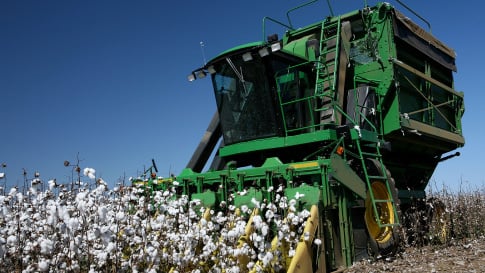Growing Cotton – Crop Nutrition 101
What you need to know about cotton fertilization, best practices, and more
Crop Nutrition Information for Growing Cotton (Gossypium hirsutum L.):
-
Cotton belongs to the genus Gossypium and the family Malvaceae.
-
Gossypium hirsutum, commonly known as upland cotton, accounts for the majority of cotton production in the US.
-
Cotton, a DD60 crop, emerges quickest from warm, most soil and grows more slowly on days below 60F
-
During peak growth months (June and July) nutrients must be readily plant-available
-
Nutrients like nitrogen, sulfur, and boron are more mobile soil, making soil sampling less reliable for these. But for nutrients like phosphorus, potassium, calcium, magnesium, and checking soil acidity, soil sampling works well at any time of year.
-
Cotton plant development, including vegetative and reproductive stages, is predictably regulated by environmental factors, heat accumulation dictates development as much as time

Cotton Field

Cotton Harvest
What soil type, pH and climate does cotton prefer?
Cotton, is a significant crop in US agriculture, and thrives under specific soil, pH, and climate conditions:
- Soil Type: Cotton prefers well-drained soils with good moisture retention. Sandy loam or loam soils are ideal, providing adequate drainage while retaining enough moisture for plant growth. These soils also allow for good root development and nutrient uptake.
- pH: Cotton grows best in slightly acidic to neutral soils, with a pH range typically between 5.8 and 6.5, with 6.5 being optimal. Maintaining the soil pH within this range ensures optimal nutrient availability, particularly for essential elements like phosphorus and potassium. Liming is recommended for fields with soil pH less than 6.0, as fertilizers are most efficient when soil pH is between 6-7
- Climate: Cotton is primarily grown in regions with warm temperatures and a long growing season. It requires plenty of sunlight and warmth to support its growth and development. Germination can be hindered by temperatures below 60F or less than adequate soil moisture. Cotton plants are also sensitive to frost and require frost-free conditions throughout their growing season.
In the US, cotton is commonly cultivated in states with warm climates and adequate rainfall or irrigation, such as Texas, Georgia, California, and Mississippi. These regions provide the necessary conditions for cotton to thrive and achieve optimal yields.
Key Nutrients:
- Nitrogen is integral for healthy cotton production
- The recommended best practice is to side dress N just before early square, which is closer to the period of substantial nutrient demand by the cotton plant
- In addition to N, Phosphorus (P), Potassium (K), Sulfur (S) and Boron (B) are nutrients of importance in cotton that must be managed properly for optimum fiber quality and lint yield.
- Mid-season foliar applications of K are critical to yield and quality
- Plant stress greatly impacts nutrient uptake, and can be influenced by anything from soil texture and drainage to weather and field preparation. Regular soil testing remains the most reliable method to guide fertilization decisions, ensuring a balanced nutrient program essential for achieving high yields.
Nutrient Removal by Cotton:
Nutrient balance is key to quality yields.
2 bales/A (cotton lint & seed lb/A) – (Alabama Extension: ANR-0449)
N – 63
P2O5- 25
K2O-31
Ca -4
Mg-7
S -5
Role of Nutrients:
- Nitrogen (N) supports vegetative growth, leaf development, and chlorophyll production, essential for photosynthesis and overall vigor.
- Phosphorus (P) is crucial for root development, flowering, and fruiting, facilitating energy transfer and early root establishment.
- Potassium (K) enhances stress tolerance, regulates water uptake, and improves fiber quality, vital during boll filling.
- Calcium (Ca) maintains cell wall integrity, supporting structure in rapidly growing tissues.
- Magnesium (Mg) is integral to chlorophyll formation, enzyme activation, and energy transfer processes.
- Sulfur (S) aids protein synthesis and overall plant health, particularly beneficial in sulfur-deficient soils.
- Micronutrients like iron (Fe), manganese (Mn), zinc (Zn), copper (Cu), boron (B), and molybdenum (Mo) are essential for metabolic functions, enzyme activities, and overall plant health.
Key quality and yield parameters can be affected by different nutrients. See how they can influence your harvest.
+ = improving
– = decreasing
+/- = different results, depending on the rate of nutrient applied
Yield: N++, P+, K++, Mg+, Ca+, S+ Quality: N+/-, P+, K++, Mg++, Ca++, S+
The Importance of Fertilizer Application Timing
A strategic fertilizer program aligns applications with cotton’s growth stages to optimize nutrient uptake. This approach ensures cotton plants receive balanced nutrition, fostering vigorous growth and maximizing productivity.
- Nitrogen should be applied judiciously during boll filling to prevent carry-over effects.
- Phosphorus benefits from “at planting” applications to overcome uptake limitations in cool soils.
- Potassium and boron are critical during boll filling to maximize yield and fiber quality.
- Stable nutrients like phosphorus, potassium, calcium, and magnesium remain in place unless soil disturbance occurs, while nitrogen, boron, and sulfur are vulnerable to losses before plant uptake.
- Mid-season foliar application (specifically of K) during peak bloom or the first four weeks of bloom have shown to be crucial for fostering flower development and boll formation. Read the trial here.
- A single application of Polysulphate before planting provides sufficient sulfur for the entire cotton crop. It can also be used alone or mixed with other fertilizers to meet the crop’s potassium (K) and magnesium (Mg) requirements throughout its growth cycle.












